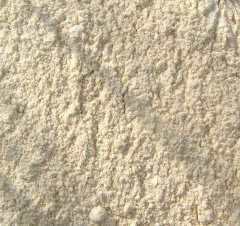Difference between revisions of "Carob Kernel Meal"
(→Description) |
|||
| (2 intermediate revisions by one other user not shown) | |||
| Line 1: | Line 1: | ||
{{Infobox_Seeds | {{Infobox_Seeds | ||
| − | | image = | + | | image = carob kernel meal.jpg |
| origin = - | | origin = - | ||
| stowage factor = - | | stowage factor = - | ||
| Line 12: | Line 12: | ||
[[Flour]] made by grinding the kernel of the Carob bean. | [[Flour]] made by grinding the kernel of the Carob bean. | ||
| − | Shipped in plastic, paper or | + | Shipped in plastic, paper or jute sacks and in multi-ply paper sacks with a polyethylene lining. Used in the food industry. Liable to loss in weight due to seepage from torn sacks. In high humidity will absorb moisture. This is likely to happen in sacks without polythene lining. <br><br>If packing is damaged any moist air entering will promote the growth of bacteria leading to mould growth. This may render the meal unfit for use in the food industry, although still usable as animal feed. The absorption of any odour will also render it unusable in the food industry. Flour obtained by grinding Carbo pods may only be used as animal feed. |
<br><br> | <br><br> | ||
| − | < | + | See also [[Carob Beans]]<br><br> |
| + | |||
| + | [[Category:Products]] | ||
[[Category:Seeds and agriproducts]] | [[Category:Seeds and agriproducts]] | ||
| − | |||
Latest revision as of 14:03, 31 October 2012
| Infobox on Carob Kernel Meal | |
|---|---|
| Example of Carob Kernel Meal |  |
| Facts | |
| Origin | - |
| Stowage factor (in m3/t) | - |
| Angle of repose | - |
| Humidity / moisture | - |
| Oil content | - |
| Ventilation | - |
| Risk factors | - |
Carob Kernel Meal
Contents
Description
Flour made by grinding the kernel of the Carob bean.
Shipped in plastic, paper or jute sacks and in multi-ply paper sacks with a polyethylene lining. Used in the food industry. Liable to loss in weight due to seepage from torn sacks. In high humidity will absorb moisture. This is likely to happen in sacks without polythene lining.
If packing is damaged any moist air entering will promote the growth of bacteria leading to mould growth. This may render the meal unfit for use in the food industry, although still usable as animal feed. The absorption of any odour will also render it unusable in the food industry. Flour obtained by grinding Carbo pods may only be used as animal feed.
See also Carob Beans











